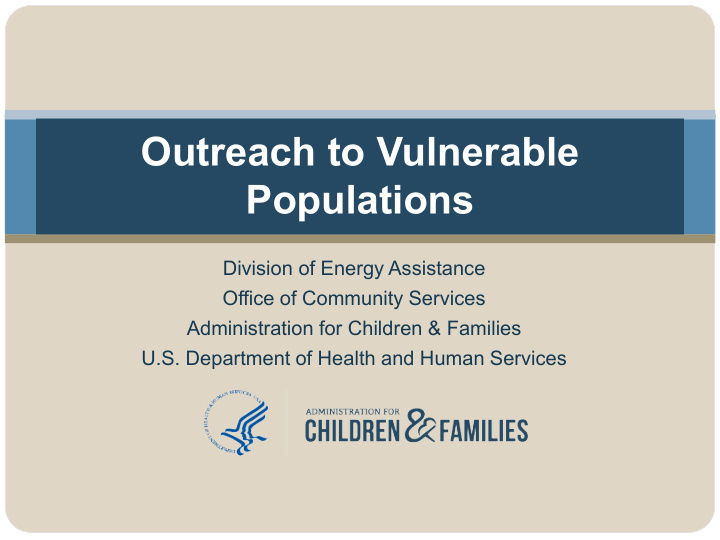



Outreach to Vulnerable Populations Division of Energy Assistance Office of Community Services Administration for Children & Families U.S. Department of Health and Human Services
Agenda Overview Vulnerable Populations Panelist Presentations Questions 2
Overview Before these panel discussions take place, we will review the purpose of outreach in LIHEAP. 3
Outreach Purpose ASSURANCE 3 Conduct outreach activities designed to assure that eligible households, especially households with elderly individuals or disabled individuals, or both, and households with high home energy burdens , are made aware of the assistance available under this title, and any similar energy- related assistance available under subtitle B of title VI (relating to community services block grant program) or under any other provision of law which carries out programs which were administered under the Economic Opportunity Act of 1964 before the date of the enactment of this Act … 4
Effective Outreach Make eligible households aware of programs for which they may be eligible: Weatherization Assistance Program (WAP) Utility-Funded Rate Assistance Program Effective outreach can streamline the following: Application process Enrollment process May be necessary to carry out some outreach activities more than once or continuously to ensure targeted populations are aware of LIHEAP 5
Discussion Panel Outreach Techniques and Materials Development Geared Toward The Disability Community Kelly Monroe Executive Director, The Arc of Louisiana 6
The Arc of Louisiana • A grassroots organization of and for people with intellectual and developmental disabilities and their families • Devoted to promoting and improving supports and services • 6,000+ members • 20 local chapters 7
Individuals with a Disability Estimated 48.9 million people Estimated 24.1 million people have a severe disability. 8
Outreach Plan Success begins with an outreach plan: Organize your efforts. 1. Ensure support. 2. Develop a plan. 3. 9
Strategies for Reaching Out to the Disability Community Two key areas to focus on: 1. Education 2. Partnerships 10
Education Understanding the disability community: 1. Gather information. 2. Educate your staff. 11
Partnerships Partnerships are the key to successful outreach: Start early: Develop the relationship before it is needed. Initiate meetings with leaders of local disability organizations. Develop and maintain relationships with key leaders. 12
Successful Communication Material development: Design outreach materials with accessibility in mind. Be direct and clear. Avoid wordiness and clutter on slides and documents. 13
Microsoft PowerPoint and Document Dos Do : Use fonts like Arial, Verdana, and Tahoma. Use a dark font color with light background. Use a large font size: Microsoft PowerPoint – 22-point font Documents – 12 - 18-point font Keep the slide simple to avoid distraction. Number your slides. Include contact information on the last slide. 14
Microsoft PowerPoint and Document Don’ts Don’t: Do not use cursive or fonts with too much detail. Do not use a design, photo, or watermark behind the slide. Do not use graphs and charts if it is not necessary. Do not use sounds or animations. 15
Resources The Arc: http://www.thearc.org/find-a-chapter American Association on Intellectual and Developmental Disabilities: https://aaidd.org National Association on Councils for Developmental Disabilities: http://nacdd.org/councils/ 16
The Arc of Louisiana Kelly Monroe Executive Director 225-383-1033 kmonroe@thearcla.org www.thearcla.org 17
Discussion Panel Outreach to Vulnerable Populations: Seniors Randy Feliciano Program Manager, Center for Benefits Access Improving the lives of 10 million older adults by 2020 18
About NCOA Who We Are: Respected national leader and trusted partner to help people aged 60+ meet the challenges of aging Our Vision: A just and caring society in which each of us, as we age, lives with dignity, purpose, and security
NCOA’s Center for Benefits Access Web site: www.ncoa.org/centerforbenefits Funded by the U.S. Administration for Community Living (ACL) Help community-based organizations find and enroll low-income seniors and younger adults with disabilities into benefits for which they are eligible
Why Don’t Seniors Apply for Benefits? Lack of awareness about programs Misconception that some programs are only for households with children Assumption that a lot of paperwork is involved Do not know where to begin “Other people need more help than me”
Where Do Seniors Get Trusted Info? Top trusted messengers: Medicare & Social Security office Doctor/nurse Local aging agency Partner/spouse Top sources of news: Local TV news National TV news Local newspaper Internet news sites
About the Aging Network State Health Insurance Assistance Programs (SHIPs) are federally funded to provide free, impartial advice about Medicare to beneficiaries and families Also offer Medicare Savings Programs/Extra Help application assistance Find your local office at www.shiptacenter.org or call 1-877-839-2675 Local aging organizations (Area Agencies on Aging, Aging & Disability Resource Centers) often offer benefits assistance Seek them out using Eldercare Locator at www.eldercare.gov or call 1-800-677-1116 Benefits Enrollment Centers (BECs): NCOA’s network
Benefits Enrollment Centers (BECs) NCOA funds 59 BECs serving individuals in 31 states Provide comprehensive screening, application assistance, and follow-up for all of the programs for which a person might be eligible Welcome partnerships and referrals Web site: www.ncoa.org/becs
Successes From the Field Examples of BECs successful outreach strategies: Hosting large centralized enrollment fairs (e.g., farmers 1. market in Tennessee, annual county fair in San Francisco, senior center holiday party in Dallas) Drop-off box approach (Duke University BEC) 2. Prescription for Cost-Saving Benefits (Kentucky) 3. Building Trust through Peer-to-Peer Volunteers 4. (New York City) To learn more, visit: https://www.ncoa.org/centerforbenefits/promising-practices/.
Contact Information Randy Feliciano Program Manager Center for Benefits Access 571-527-4008 randy.feliciano@ncoa.org
Discussion Panel Outreach to Vulnerable Populations Alfreda Tillman Bester Assistant Secretary of Family Support, Louisiana Department of Children & Family Services 27
DCFS Outreach to Families Traditional News Media Community Partners (civic, social, faith-based) “Conversations with the Secretary” Social Media Toll-free helplines DCFS Web site
Web Site Statistics 3 million users (2016) 76.5% female (as of 1/1/17) Highest engagement: 25 – 34-year-olds (as of 1/1/17)
DCFS Services DCFS toll-free helpline: 1-888-LAHELP-U Report Child Abuse: 1-855-4LA-KIDS
Contact Information Alfreda Tillman Bester, MBA, JD Assistant Secretary of Family Support Louisiana Department of Children & Family Services 225-342-0541 Alfreda.TillmanBester.DCFS@la.gov
Questions? 32
Recommend
More recommend